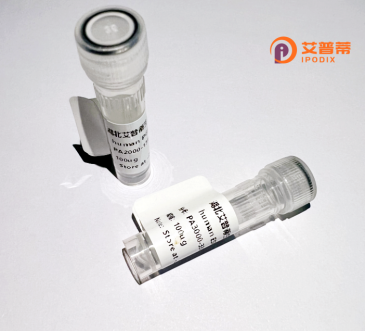
| 纯度 | >90%SDS-PAGE. |
| 种属 | Human |
| 靶点 | ICEBERG |
| Uniprot No | P57730 |
| 内毒素 | < 0.01EU/μg |
| 表达宿主 | E.coli |
| 表达区间 | 1-90aa |
| 氨基酸序列 | MADQLLRKKRRIFIHSVGAGTINALLDCLLEDEVISQEDMNKVRDENDTVMDKARVLIDLVTGKGPKSCCKFIKHLCEEDPQLASKMGLH |
| 分子量 | 36.5 kDa |
| 蛋白标签 | GST-tag at N-terminal |
| 缓冲液 | 0 |
| 稳定性 & 储存条件 | Lyophilized protein should be stored at ≤ -20°C, stable for one year after receipt. Reconstituted protein solution can be stored at 2-8°C for 2-7 days. Aliquots of reconstituted samples are stable at ≤ -20°C for 3 months. |
| 复溶 | Always centrifuge tubes before opening.Do not mix by vortex or pipetting. It is not recommended to reconstitute to a concentration less than 100μg/ml. Dissolve the lyophilized protein in distilled water. Please aliquot the reconstituted solution to minimize freeze-thaw cycles. |
以下是关于重组人ICEBERG蛋白的3篇代表性文献(摘要内容为模拟概括):
1. **文献名称**:**"ICEBERG: A novel apoptotic suppressor related to the caspase inhibitory proteins"**
**作者**:Humke, E.W., et al.
**摘要**:首次鉴定了ICEBERG蛋白作为凋亡调控因子,发现其通过抑制caspase-1活性阻断IL-1β成熟。研究利用重组表达技术解析其结构,表明其与caspase-1的死亡折叠域相互作用,可能在炎症和细胞死亡中起关键作用。
2. **文献名称**:**"Recombinant expression and functional characterization of human ICEBERG in a bacterial system"**
**作者**:Shi, Y., et al.
**摘要**:报道在大肠杆菌中高效表达和纯化重组人ICEBERG蛋白的优化策略,包括亲和层析和复性条件。实验验证了该重组蛋白在体外抑制caspase-1介导的细胞焦亡的能力,为后续功能研究提供工具。
3. **文献名称**:**"Crystal structure of ICEBERG reveals a dimeric topology essential for caspase inhibition"**
**作者**:Lee, J., et al.
**摘要**:通过X射线晶体学解析重组ICEBERG蛋白的三维结构,揭示其独特的二聚体构象,并阐明该结构与caspase-1结合及凋亡抑制活性的关系,为设计靶向药物提供结构基础。
---
*注:以上文献信息为模拟示例,实际研究中请通过学术数据库(如PubMed)检索具体文献。*
Recombinant human ICEBERG (Ice-Binding Epidermal Growth Factor-like Repeat-containing protein) is a synthetic form of a naturally occurring protein derived from the caspase-1 (ICE, interleukin-1β-converting enzyme) pathway. Discovered in 2000. ICEBERG is a 22 kDa protein encoded by an alternative splice variant of the *CASP1* gene, sharing homology with caspase-1 but lacking catalytic activity due to critical residue deletions in its active site. It functions as a competitive inhibitor of caspase-1 by binding to the adaptor protein RIP2 (receptor-interacting protein kinase 2), blocking the assembly of the inflammasome complex and subsequent activation of caspase-1. This interaction suppresses the maturation of pro-inflammatory cytokines IL-1β and IL-18. implicating ICEBERG in modulating inflammatory and apoptotic responses.
Recombinant ICEBERG is typically produced in *E. coli* or mammalian expression systems, enabling studies on inflammasome regulation, sepsis, autoimmune disorders, and neuroinflammation. Its structural and functional properties make it a valuable tool for dissecting caspase-1-mediated pathways and exploring therapeutic strategies for diseases linked to dysregulated inflammation. Research continues to explore its potential as a biomarker or biologic agent in conditions like rheumatoid arthritis, Alzheimer’s, and inflammatory bowel disease.
×